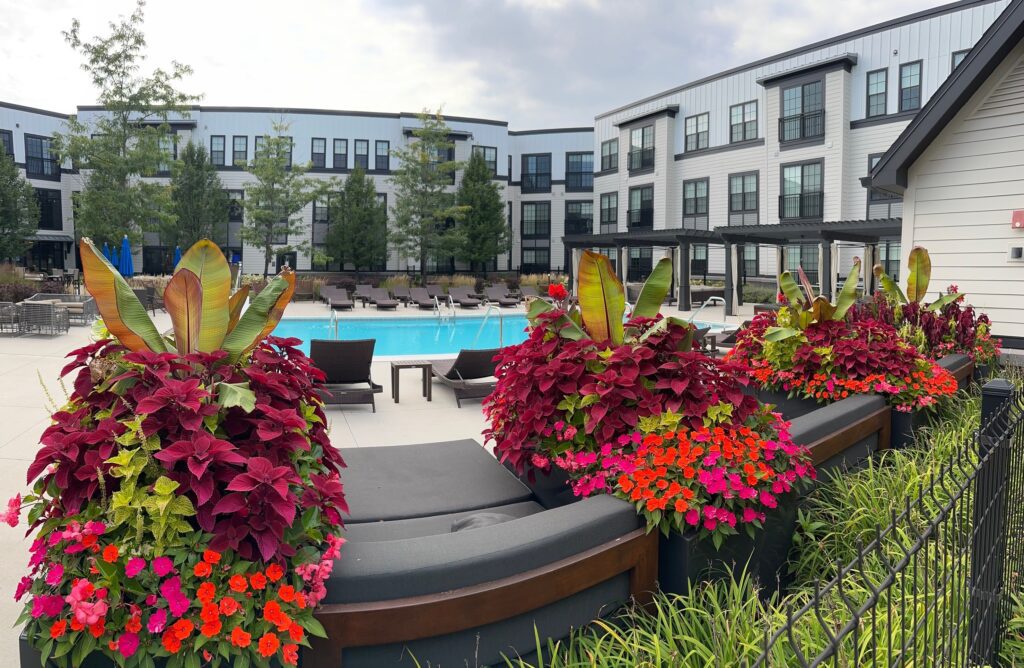
Creating a beautiful and functional outdoor space involves more than just adding a few chairs or planting a couple of flowers. The goal is to design a space that you can enjoy year-round, whether you’re hosting summer barbecues, relaxing with a book in the spring, or cozying up by a fire pit in the fall. A well-planned landscape combines aesthetics and functionality, ensuring that your outdoor area can evolve with the seasons and offer a relaxing environment for you and your guests.
Here are some essential tips to create an inviting and versatile outdoor space:
1. Plan with Purpose: Functionality Meets Aesthetics
The first step in creating an outdoor space is deciding how you want to use it. Do you envision a place to entertain guests, a tranquil retreat for personal relaxation, or both? Map out different zones for each activity, like an area for dining, a lounge section, and maybe a play area if you have children.
- Entertainment Area: Add a patio or deck with comfortable seating, dining tables, and outdoor cooking spaces such as a built-in grill or pizza oven.
- Relaxation Zone: Create a quiet corner with plush seating, a hammock, or even a water feature to promote serenity.
2. Choose the Right Greenery for All Seasons
Incorporating a variety of plants is key to ensuring your space looks lively year-round. Consider trees, shrubs, and flowers that provide visual interest in all four seasons.
- Spring Blooms: Plant flowering shrubs like azaleas, rhododendrons, and magnolias that will burst into bloom in the spring. Add bulbs like daffodils and tulips for bright pops of color.
- Summer Color: Consider perennials like lavender, salvia, and coneflowers, which thrive in the summer heat. Ornamental grasses also make for great summer accents.
- Fall Foliage: Trees like maples and oaks bring brilliant fall colors, while shrubs like burning bush add vibrant red hues. Plant chrysanthemums for late-season blooms.
- Winter Interest: Incorporate evergreens such as junipers, pines, and hollies, which maintain their shape and color during the colder months. Trees like dogwoods and birches provide striking bark texture.
3. Incorporate Trees for Shade and Structure
Trees are essential for both visual appeal and practical purposes. They create structure in your landscape, provide shade, and contribute to privacy. Plant large canopy trees, like oaks or maples, in areas where shade is needed. For smaller spaces, consider ornamental trees like Japanese maples or crape myrtles.
- Multi-Season Benefits: Deciduous trees provide shade in the summer and allow sunlight to filter through in the winter, helping regulate your outdoor space’s temperature naturally.
- Privacy and Windbreak: Trees and tall shrubs can act as a natural barrier for noise reduction and privacy. Consider layering with a mix of heights for a soft, natural look.
4. Add Shrubs for Structure and Versatility
Shrubs are the backbone of landscaping design. They provide structure, define spaces, and fill in gaps between trees and ground-level plants. Opt for both evergreen and deciduous varieties to keep your yard looking lush throughout the year.
- Low Maintenance Choices: Boxwoods and yews are hardy, evergreen shrubs that maintain their form throughout the year. Hydrangeas, with their large flower heads, add beauty from late spring through fall.
- Flowering Shrubs: Roses, lilacs, and butterfly bushes can add a splash of color and fragrance to your space. Position these near seating areas to enjoy their beauty up close.
5. Embrace Perennials and Annuals for Year-Round Color
To keep your outdoor space vibrant, plant a mix of perennials and annuals. Perennials come back year after year, while annuals can be changed seasonally for fresh color.
- Perennials: Hostas, daylilies, and black-eyed Susans provide long-lasting beauty without much upkeep. These plants often require less water and maintenance once established.
- Annuals: Geraniums, petunias, and marigolds offer quick and easy color. Swap them out each year to keep your garden feeling fresh.
6. Consider Hardscape Elements for Functionality
In addition to plants, well-planned hardscape features are essential to a functional and enjoyable outdoor space. Stone walkways, patios, retaining walls, and fire pits add both utility and beauty.
- Patios and Decks: Extend your living space with a well-designed patio or deck, perfect for entertaining guests. Use natural stone, pavers, or composite decking to create a low-maintenance surface.
- Fire Features: Fire pits or outdoor fireplaces make your outdoor space usable even in colder months. They provide warmth and ambiance for fall and winter gatherings.
- Water Features: Incorporating a small fountain or pond can help create a relaxing atmosphere. The sound of running water is soothing and can drown out unwanted noise from nearby roads.
7. Lighting for Evening Enjoyment
Outdoor lighting can transform your yard into an enchanting evening retreat. Illuminate pathways with solar-powered lights or use string lights for a festive touch. Spotlights can highlight trees, shrubs, and architectural elements, while lanterns and candles create a cozy ambiance.
Conclusion
By combining lush greenery, functional hardscapes, and seasonal interest, you can create an outdoor space that provides year-round enjoyment. Whether you’re relaxing with family or hosting a get-together, a well-designed landscape will offer both beauty and functionality. For the best results, consult with a landscaping professional who can help tailor your outdoor space to suit your specific needs and aesthetic preferences.

